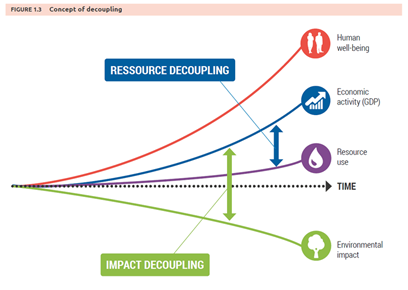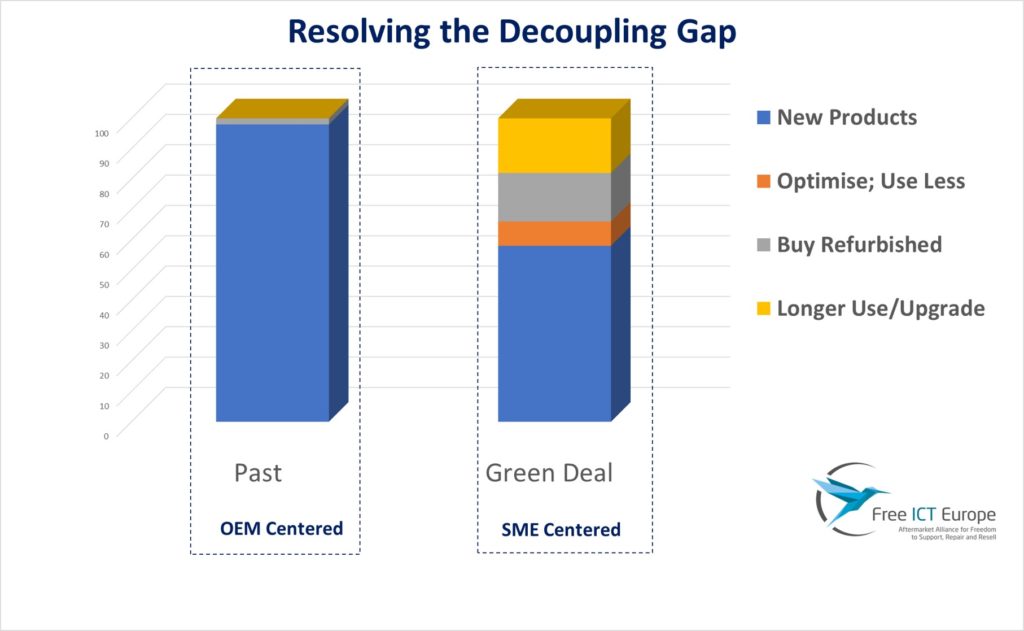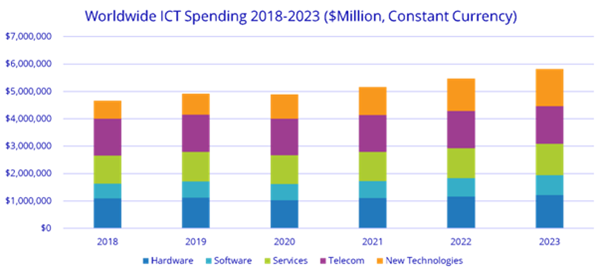ITAM & decoupling: Smart Fringe Solutions for a Better World
Jan Hoogstrate and Astrid Wynne of Free ICT Europe discuss ITAM’s role in decoupling economic growth from resource consumption as we all stride for a more sustainable future.
Governments across the globe are looking at ways to promote a transition towards a world where we use less without giving up our quality of life – “decoupling” is one such method, and it’s something ITAM can help to deliver. One of the main goals of initiatives like the EU’s Circular Economy Action Plan (AP), and the European Commission’s Green Deal, is to decouple economic growth from resource consumption. However, this will only be possible if we change attitudes towards procurement, and IT Asset Management (ITAM) professionals have a real opportunity to lead the way in this.
The concept of decoupling is visualised in the figure below, where increased human well-being and economic activity relies less on resources from the natural environment and more on resource efficiency through reuse, repair and recycling. It is applicable to both developed economies and developing economies whose acquisition of technology is growing at a faster rate and therefore represent a larger opportunity for positive progress in this regard.

Source: UN Environment Program
This idea might appear utopian to some, but it has gained support from mainstream economists and (financial) consultancies up to G7 & G20 attention. Unlike the linear model mankind has been working to for decades – where we take resources from the natural environment in order to make products that are used for a limited time and then become that needs to be treated – this alternative view that sees waste as a form of resource has been described as a “system that is regenerative by design.” In reducing its reliance on new production, society is able to develop novel business sectors such as repair, maintenance, refurbishment, remanufacturing and recycling.
It is particularly useful in the technology sector as electronic waste is the fastest growing waste stream on the planet. Approximately 57m tonnes were produced in 2021, surpassing the 52.2 million tonnes estimated in back in 2017. Research from European think tank The Shift Project says that digital technologies were responsible for around 3.7% of global greenhouse gas emissions in 2019.
The driving motivation and most important factor in decoupling is to reduce our reliance on New Products, which are putting increasing pressure on our limited resources and are responsible for a large amount of carbon emissions. At the same time, we need to ensure we have the correct amount of infrastructure to deliver what business and society needs. Hence, there is a gap between policy demands and the requirements of organisations. In order to solve this, we need to switch procurement policies away from a reliance on new equipment from OEMs to a mixture of internal product life extension, use of refurbished and optimisation of assets (and storage of data) as seen in the diagram below.

Another element of this direction is that local providers can play a big role. While we were previously guided and serviced solely by the OEM channel, this will now become a hybrid solution with SME partners, the experts in life-cycle extension.
This concept has huge benefits for those working in the ITAM profession because it represents a way to save money, time and realise ESG (Environmental, Social and Governance) benefits at the same time. How could the idea of reducing procurement of new products by 40% be anything other than tempting?
The supply and demand gap
As reported by , spending on ICT is still on the rise, with new purchases growing by at least 5% annually, showing the demand is still growing. This needs to change if we are to realise the dream of decoupling our economic activity from spend on new products. In contrast, there are significant supply chain issues which are challenging the traditional model. Many are familiar with the ongoing chip shortages that began in 2019 and continue to shut down production in major industries, leading to long delivery times for commodities like IT and vehicles. Future issues include the (lack of) availability of Critical Raw Materials (CRMs), the elements of the periodic table that are of growing economic importance (especially in ICT) but come with high risk of supply shortage.
Some of these CRMs are predicted to run out in decades; some come from politically unstable areas, while others are simply in short supply. If we are to fulfil our increased need for technological devices, an effective change is required in how we procure, use and dispose of equipment.

Source: IDC Spending Forecast
Lessons learned during the pandemic
During the pandemic, an increasing number of organisations and individuals were forced to look at alternative solutions for IT procurement due to the unavailability of new products. The independent ICT aftermarket was one such solution. Essentially composed of SMEs, it provides quality secondhand products and upgrade options with terms and conditions that are either the same or better than those offered by OEMs. These products can be supported by third-party maintenance contracts and software support. Whilst the initial decision was made out of necessity, this could signal a sea change in the way companies procure and maintain their IT.
A change of mindset
Changing procurement choices at scale via aftermarket products and services creates a valuable contribution to the EU’s Circular Economy goals. Stimulating the secondary hardware market and linked sectors (e.g., maintenance, reuse, repair, and third-party software providers) extends product life-cycles, reduces reliance on new resources and buys society time to develop recycling technologies to recover CRMs.
Near-term benefits for ITAM professionals include decreases in cost and lead times as well as greater choice in managing the estate. Rather than having contracts dictate when and how they can refresh hardware, professionals can choose alternatives that are better on cost and environmental performance. These include cascading assets, in-house refurbishment and a clearer view on reuse and waste management. This ultimately leads to a lower total cost of ownership of products and lower staff costs. A side benefit is that it protects and promotes local supply, reducing supply chain risks and vendor dependencies and increasing local digital sovereignty.
The opportunity for the ITAM sector
This could mark the beginning of a more sustainable mix in the global ICT estate, reducing reliance on mining and manufacturing, which will in turn cut pollution, greenhouse gas emissions and resource depletion. Doing this requires an ecosystem filled with multiple specialised service and product suppliers that exist side by side with the OEMs focused on the development of cutting-edge technologies. It is a chance to make an impact on environmental sustainability whilst simultaneously improving budgets.
Non-consumer sectors (private and public) account for 63% of ICT Spending (IDC Data). These sectors have the ability – and even the responsibility – to create lasting, meaningful change in the way we produce, procure and consume resources in the digital sector. They can realise this opportunity with a series of policies led by ITAM professionals. These are:
- Extend the life of your IT products. The single most important thing you can do to reduce the environmental footprint.
- Be adaptable with your procurement strategy and tailor these to your IT assets and users.
- Cascade (redeploy) older equipment to areas with lower compute needs.
- Make it a policy to include the upgrades, maintenance and repairs needed to extend refresh s, using third-party maintenance suppliers where applicable.
- If you need to buy a product, first focus on used/refurbished options.
- Choose to buy new products from manufacturers that score highly on repairability, energy efficiency and materials usage. Ensure there are no obstacles to third-party support and resale such as software lock-ins. Include open-source options into your scope.
- Make sure contracts do not limit product life extension or impose any obstacles on reuse resale so that equipment can be passed to another user.
- Choose reuse over recycling for redundant IT hardware by choosing an ITAD specialist that is qualified in end-of-life management as well as preparation for secondary use. Ask for a percentage of reuse from your ITAD provider.
- Using the embodied carbon metrics available online, attempt to offset the footprint of your new product.
The 2020s must be the decade of action if future generations are to enjoy at least the same quality of life as us. Extending IT product life is one huge step we can make to making this a reality.
About the authors
Jan and Astrid are board members at Free ICT Europe, a non-profit organisation that works with EU legislators to provide increased choice and environmentally sustainable procurement choices within the IT sector. Having worked with governmental, research and non-profit organizations operating within the Circular Economy space, we have found that there is a crucial role for SMEs in decoupling economic growth from environmental damage, and that IT Asset Managers can help stimulate its development.
- Tags: podcast-include
